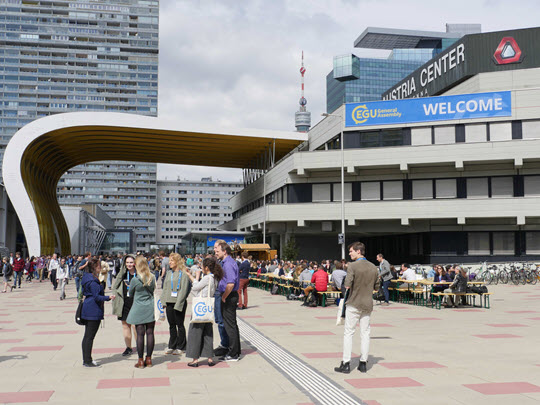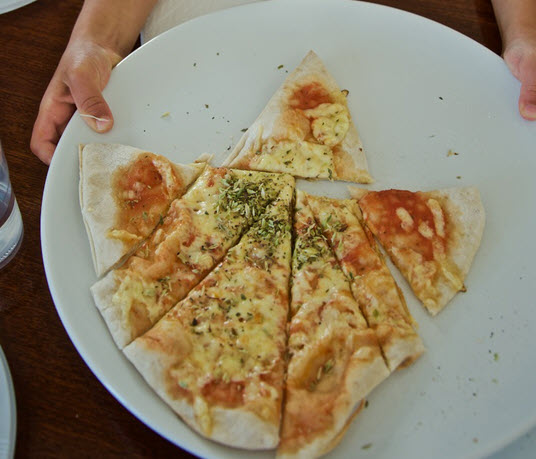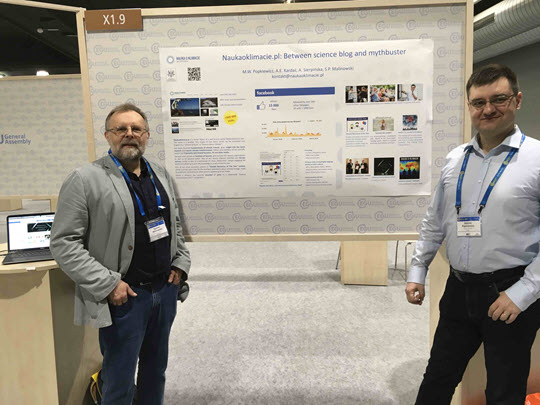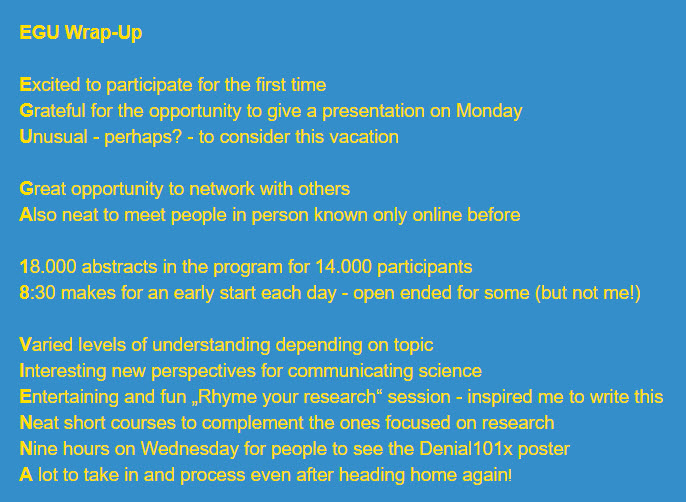Skeptical Science at EGU 2018 - a personal diary
Posted on 19 April 2018 by BaerbelW
As mentioned in an earlier post, SkS was involved with some sessions at the European Geoscience Union's General Assembly in Vienna held from April 8 to 13. This blog post is my personal recap of some of the sessions I visited and of the two I actively participated in. As I do all my climate-related activities in my spare time the week in Vienna was vacation for me from my actual job in IT. This had the big advantage that I could basically pick and choose which sessions to go to as I didn't have to be anywhere specific apart from the two sessions I presented in. And yes, this may not be everybody's idea of how to spend a vacation, but I consider it time well spent!
As this is a fairly long post, you can jump to the individual days via these direct links:
- Monday, April 9 - Includes the myth-debunking short course
- Tuesday, April 10 - just browsing some sessions
- Wednesday, April 11 - Denial101x poster in session EOS13
- Thursday, April 12 - Climate negotiations and Education in geoscience
- Friday, April 13 - Another poster session and wrapping-up

Monday, April 9
As this was my first time at the EGU General Assembly, I figured it would be a good idea to start off with a short course offered specifically for newbie-attendees like myself: How to navigate the EGU: tips and tricks. It made for an early start but was well worth it with giving us all the lay of the land both for EGU in general and the General Assembly in particular. We learned how the EGU is organised, that it's a non-profit bottom-up organisation with currently about 15,000 members. They had almost 18,000 abstracts submitted for EGU 2018.
To get some more details, I then went to the EGU Planeray session scheduled over lunch, which meant that attendees got treated to some free lunchtime snacks. I wonder if the room would have been quite as packed without those goodies!
The first talk in the early afternoon session CL2.03 about detecting and attributing climate change, Stefan Rahmstorf gave a preview about an upcoming paper with Stephan Lewandowsky, Kevin Cowtan and Ari Jokimäki among the co-authors. They explored if there ever actually was evidence for a „hiatus“ or „slowdown“ in global temperaturers. Their short answer: „No“. For some more details, please see the session-abstract for details.
By the time most of the talks in that session had been given, I needed to head down to level -2 in the conference center to get ready for the short course I was presenting in. The session „Debunking myths and fake news: how can geoscientists fight misinformation and false claims“ was structured as a combination of four short presentations followed by a Q&A section. Here is a picture of the four panelists in the sequence of their talks: top right - Cindy Mora-Stock talking about her Twitter activities related to earth-quakes, bottom right - Solmaz Mohadjer explaining her on the grounds work with school children in earthquake prone Tajikistan, bottom left - myself talking about debunking myths, and last but not least Bob Ward explaining why and how scientists should get involved with debunking misinformation.
 (All pictures: Barbara Fereira - click for larger image)
(All pictures: Barbara Fereira - click for larger image)
Here is how Solmaz summarised her work which provides an example of misinformation spread due to lack of knowledge instead of idealogical biases as is so often the case with climate science:
"In 2008, we developed, tested and published a set of curricular materials on earthquake science, hazards and safety (Mohadjer et al., 2010). The materials included lesson plans designed to be used by middle and high school teachers globally. All content was tested with school students in Dushanbe, Tajikistan. To assess their preconceptions and misconceptions about earthquakes prior to curriculum implementation, we conducted interviews with each student during which we asked a series of questions such as "What are the causes of earthquakes? What is inside the Earth? Can one prepare for earthquakes?" Despite having experienced multiple earthquakes, most students used a combination of disconnected facts and non-scientific concepts to explain why earthquakes occur. Some responses included stories of animals living inside the Earth and their motion causing earthquakes as well as references to God. This short video clip includes some of their answers. The effectiveness of the curriculum in communicating earthquake information was evaluated after curriculum implementation in a series of post-assessment discussions which showed a significant improvement in students' understanding of earthquakes. In the last 10 years, the curricular materials have been used in many locations around the world including China, Haiti, Afghanistan and India. More recently in 2016, with support from the European Geosciences Union, the educational materials were turned into learning videos following a paired-teaching technique developed by the MIT BLOSSOMS. These videos are now available free of charge at http://parsquake.org/."
Then it was my turn to talk about „How to communicate effectively when faced with myths and misinformation“. The presentation I had put together was basically a „mash-up“ of material created by John Cook for his various talks and workshops, distilled down to 10 minutes in length. You can download a PDF-version of the slides here or - as some of the slides are not self-explanatory - you can watch a pre-recorded version on YouTube which comes with audio (not necessarily the exact same words as in the short course but close enough). This has also been added to our talks-page. If you are interested in the slide-deck mentioned at the end, you can read about it in this recently published post or just download it from here.
Tuesday, April 10
As I didn‘t have any sessions I „had“ to attend, I decided to give the short course „Rhyme your research“ a try. This was a fun session to pick as the very first thing Sam Illingworth and Tim van Emmering had us do was to draw the person sitting next to us while only looking at their face but NOT the piece of paper we were drawing on. I‘m sure you can imagine how those results looked like! They then had us do various poem and poetry-related activities culminating in a collaboratively created poem about science. You can find some examples for both activities on Twitter via #EGU18 and looking through Sam‘s or Tim‘s Twitter streams (@samillingworth and @TimVanEmmerick respectively).
In the afternoon I wandered around the poster hall for a while taking in several education-related posters including one by Solmaz Mohadjer about earthquake education in schools.
The last session for me on Tuesday was the short course "Communicating geoscience to the media". Interest in the session was high so that there was standing (or "sitting on the floor") room only for late arrivals. The panelists talked about their varied and diverse experiences both from a scientist's and a journalist's perspective. The most memorable quote for me from the session came from Sophie Berger: "Science ist not over until it's communicated".
Wednesday, April 11
I went to the conference center early to put up our Denial101x poster for session EOS13 "Climate change education". I had already found out on Monday that the sticker tape and the poster printed on cloth wouldn‘t go too well together, so I had attached some string to the lugs to be able to fasten it securely. With the help of a service team member it was then easy enough to securely attach the poster without risking it falling down during the day (which happened to quite few of the posters throughout the days).
click for larger image
You can the download the poster as a PDF-file, but with 26MB it's fairly large!
Session EOS13 had an oral part during the morning with 6 presentations highlighting various aspects of how to teach climate change. One of the presentations was given by Nabanita Borah about "Turning Misinformation into Educational Opportunities" which she is working on with John Cook. They are putting together a high school climate change curriculum based on the misconception-based learning framework.
In the afternoon, we were expected to be at our posters for at least 90 minutes between 15:30 and 17:00 and this was a good opportunity to talk with several people about Denial101x specifically and Skeptical Science in general. Just like at AGU in 2016, it was rewarding to get feedback from several people that they not only know SkS but keep sending folks our way!
Thursday, April 12
Even though I'm not necessarily a big fan of role plays, I joined the short course "World Climate: an interactive simulation of climate negotiations" during the morning sessions. This turned out to be quite interesting with the first part explaining how the simulation works, who is the intended audience and what some findings from it are. The initial idea was for Climate Interactive to create a tool for the actual negotiators at COP21 in Paris with which they could calculate the overall result of the various pledges. The role play C-ROADS was developed based on this.
After the explanation we split up in 6 teams and set our first goals for several parameters, with quite a wide spread depending on whether we represented China, India, the EU, the US, other developed and developing countries. Those pledges meant - after feeding them into C-ROADS - that we wouldn't even stay below 3°C by 2100 so a 2nd round of negotiations was called for but even after that and some "hackling" between the groups, we still came out at 2.5°C warming instead of the aimed for less than 2°C. By then, time was up and - even though we didn't achieve our goal - we at least had a better idea of how difficult it actually is to not overshoot the set threshold.
 A scenario in C-ROADS World Climate (from Climate Interactive)
A scenario in C-ROADS World Climate (from Climate Interactive)
For the afternoon I had selected "Communication and Education in Geoscience: Practice, Research and Findings" which had talks about some interesting examples of how to reach various sections of the public. Bárbara Fereira explained how she tackles the task to select press-conference worthy abstracts out of the almost 18.000 sent in. Her presentation included some tips for the scientists of how to make their abstracts "stick out". Sveva Corrado introduced the work she does with colleagues in Rome to bring science topics closer to students. By taking them e. g. on geology focused field-trips in the city's surrounding hills students have an opportunity for hands-on learning. Beatriz Tomás Oliveira explained the field trips she organises for the interested public and local school children. Salema Beach on the Portuguese coast is nearby where dinosaur footprints have been preserved. This makes for an intriguing combination to talk about geology, biology and history. According to Beatriz this outing most definitely had an impression on the kids she had on the field trips with one of them - whose father bakes pizzas - making a special dinosaur footprint pizza afterwards!
 Picture provided by Beatriz Tomás Oliveira
Picture provided by Beatriz Tomás Oliveira
Friday, April 13
The final day of EGU 2018 started off with the poster session part of EOS6 which had several interesting contributions from around the world. The one I was most interested in, was the poster Marcin Popkiewicz and Szymon Malowski were presenting as it featured the Polish partner site of SkS called Naukaoklimacie:
 Szymon Malowski (left) and Marcin Popkiewicz (right) next to their poster (larger version)
Szymon Malowski (left) and Marcin Popkiewicz (right) next to their poster (larger version)
Their website, apart from general climate-related education, is focused on Poland and the denial of human-caused climate change they encounter there mostly due to the country's dependence on coal. They take this on by "conventional" means such as lectures and media presence and "unconventional" ones such as climate quizzes with prizes or the "Climate Nonsense of the Year" voting for the dumbest statements on climate made by journalists, politicians or other persons appearing in the Polish media. While talking with them, we made tentative plans for them to translate some of their blog posts into English so that we can cross post them on Skeptical Science.
I concluded my EGU "adventure" with listening to a few talks in a session about Climate Data Homogenizations where I think I at least understood the gist of what Robert Rohde explained in his presentation about the Development of Homogenized Global Land-Surface Daily Temperature.
So, that's a wrap for my week at EGU 2018 in Vienna!































 Arguments
Arguments































Regarding debunking climate myths. I have heard the incorrect claim a lot recently that climate science can't be trusted, because the science is allegedly very new, and was developed by the United Nations for political motives. Or variations on this general theme.
The science is actually more than a century old. It might be worth adding this issue to the list of climate myths with some of the history.
I think there are fundamentally two kinds of deniers; those that ought to be open to logical and factual argument (leaders, politicians and the like) and - a much bigger number - the mass of media consumers.
The latter form by far the largest denialist groups on blogs, newspaper comment sections and so on. But attempting to argue with them using facts and logic is IMO a hiding to nothing: in the overwhelming majority of "discussions", both online and in broadcast media their tactic (both deliberate and unconcious) is to use the aptly named gish-gallop method of continually changing the subject.
There seems to me to be no way to counter this: if as soon as a logical fallacy or inconvenient and fully documented fact is used they bring up another myth or unattributable "fact" to avoid having to back up their argument one appears (to them) to be running away from new "evidence".
I have seen very little evidence of argument based on facts getting very far in changing the attitudes of such individuals.
Wol @2
Perhaps this older post will give you some ideas of how to deal with gish-gallops: http://sks.to/firehose
What I sometimes do - like in a Facebook-thread full of comments by dismissives/trolls - is to just point others following the thread at our rebuttals via the fixed numbers and short URLs. Or, to take it a step further, keep on sharing the myth-rebuttal chart ("myth bingo") where the already spouted myths have been visually ticked off:
This will of course not change the attitudes of the willfully ignorant commenters but it will at least show everybody else how wrong they are (and thereby hopefully help to inoculate them against the trolls' postings).
[DB] Reduced image width